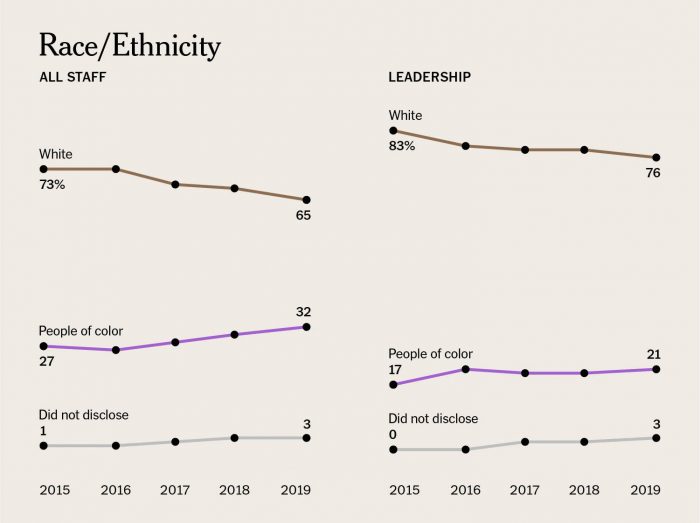
The New York Times’ annual diversity report, released late last week, showed the staff becoming increasingly diverse across gender, race, and ethnicity, but with a large gap in representation at the leadership level left to close.
At the end of 2019, women were 51 percent of the staff and held 49 percent of leadership positions. Driven by a diverse class of new hires, people of color represented 32 percent of staff and 21 percent of the Times leadership.

The Times’ report noted that “pay equity is an important part of a diverse and inclusive workplace, and we conduct pay reviews every two years to ensure fairness.” It said its 2019 analysis “found no evidence of pay discrimination” but didn’t elaborate or include results.
credit where it's due: the @nytimes has published a report looking at diversity in its own org.
But they mention that their "analysis found no evidence of pay discrimination" without publishing the results. Why publish other results and not this? https://t.co/8MvTSfGTxz
— Steven Rich (@dataeditor) May 21, 2020
The Times said it sees supporting its distributed workforce as part of its inclusive efforts. “We need to do more to build an intentional remote and distributed work culture. The coronavirus pandemic has made this even more urgent.”
The report also highlighted editorial coverage like The 1619 Project (for which Nikole Hannah-Jones won a Pulitzer Prize earlier this month) and an episode of The Daily about racism against Asian Americans as well as “candid explorations” of past failures covering AIDS and an obituary section that routinely overlooked all but white men.
“The diversity of our staff makes our report deeper and richer, and better able to address the needs and experiences of our growing, global audience,” the report concludes. “Though we’ve made progress, we know there’s always more to do. We will continue this work, which strengthens our journalism, our business and our culture.” You can read the full report online.
Very few newsrooms report diversity numbers (here’s NPR’s report from late last year; here’s ProPublica’s report from this spring; BuzzFeed last issued a report in March 2019).
Since we're getting closer to awards season, let's imagine how many more news orgs would publish diversity reports if they were a requirement for winning prestigious industry prizes https://t.co/BvJgvp1w17
— Ellis Simani (@emsimani) November 20, 2019
The Times’ report follows a dispiriting announcement from the American Society of News Editors that the group would be, at least, pausing its annual diversity census. Poynter reported on March 6 that the survey was “being scrapped,” a decision that seemed to elicit little reaction until last week when Twitter picked it up:
ASNE's diversity survey is being scrapped because outlets don't want to admit they are failing to hire and retain journalists of color. One of my former job's values was "radical inclusivity." I asked for us to participate. My boss' boss left me on read.https://t.co/bLG68D4L42
— Andrea González-Ramírez (@andreagonram) May 19, 2020
Really bad news that the ASNE diversity survey is being discontinued. Hope some industry player will pick this up. Less measurement will inevitably lead to less progress. https://t.co/6IyRBP8axv
— Richard Tofel (@dicktofel) May 19, 2020
ASNE's decision to discontinue its annual newsroom diversity survey is extremely disappointing, but not at all surprising.
Newsrooms have been aggressively reluctant about collecting and publishing these stats.https://t.co/5L0oxdw0KR
— Jie Jenny Zou (@jiejennyzou) May 19, 2020
At that point, organizers said that the survey is actually being redesigned and rethought, not completely abandoned.
Amid concerns that a new group formed by merger of American Society of News Editors and Associated Press Media Editors would end ASNE's diversity survey of newspapers, organizers say the study instead will change. Hmm. https://t.co/5TGmdNZqVM
— Eric Deggans at NPR (@Deggans) May 19, 2020
Meredith Clark, the researcher who’s run the survey for the past two years, said ASNE is “pausing on data collection this year to fully revise our approach,” and that the survey in its existing form didn’t work.
Don't panic: The @newsleaders annual diversity survey isn't ending. We are pausing on data collection this year to fully revise our approach. 1/? @aaja @NABJ @NAHJ @najournalists @nlgja @spj_tweets @ONA @womenjournos #mediadiversity
— #TenureTrackHustle (@meredithdclark) May 19, 2020
Proposed changes to the newsroom diversity survey include:
1. Conducting a demographic census of newsroom leadership for 2020 while other components are being developed. 7/? @aaja @NABJ @NAHJ @najournalists @nlgja@spj_tweets @ONA @womenjournos #mediadiversity
— #TenureTrackHustle (@meredithdclark) May 19, 2020
3. Engaging foundations, affinity organizations (like those listed here) and other power brokers to require orgs to report their demographics in order to qualify for funding, prizes, etc. 9/? @aaja @NABJ @NAHJ @najournalists @nlgja@spj_tweets @ONA @womenjournos #mediadiversity
— #TenureTrackHustle (@meredithdclark) May 19, 2020
The most recent edition was published was published in 2018 in partnership with Google. It’s one of the association’s most public-facing programs and last year’s report is still featured prominently on the organization’s homepage. Three years ago, ASNE promised to overhaul the survey “into a world-class resource to support newsroom diversity efforts” with the help of a $300,000 Democracy Fund grant. ASNE’s executive director at the time, Teri Hayt, told Laura Hazard Owen that ASNE was refocusing on diversity, not shrinking newsroom numbers. “We don’t want this to be a headline about ‘X number of jobs were lost this year in journalism.’ We kinda know that, unfortunately. We want to focus on the diversity in the news organizations, and hopefully offer some good ideas or best practices.”
Bottom line: If this element of diversity, equity and inclusion work is to survive in these perilous times, it is going to require the participation of MANY journalism stakeholders. 13/? @aaja @NABJ @NAHJ @najournalists @nlgja @spj_tweets @ONA @womenjournos
#mediadiversity— #TenureTrackHustle (@meredithdclark) May 19, 2020
The ASNE report isn’t the only organization to track newsroom diversity. Jesse Holcomb noted that Pew Research Center, Radio Television Digital News Association, and the Institute for Nonprofit News have all made efforts to collect — at least — segments of the news industry.